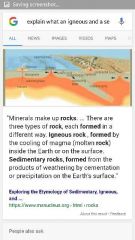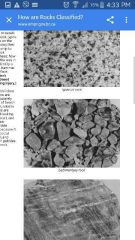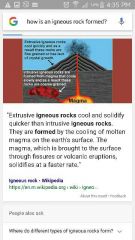![]()
![]()
![]()
Use LEFT and RIGHT arrow keys to navigate between flashcards;
Use UP and DOWN arrow keys to flip the card;
H to show hint;
A reads text to speech;
7 Cards in this Set
- Front
- Back
|
Difference between rock and mineral |
MineralsMinerals are naturally occurring substances formed by geological processes. They are usually solid and feature a crystal structure as well as specific physical properties and chemical composition.Physical properties of minerals include crystal structure, hardness (Mohs scale), lustre (how it reflects light) and color, as well as more complicated properties such as streak, fracture, cleavage and density.Mohs scale of hardness measures the ability of minerals to scratch each other. Talc is very soft and is listed as 1, diamond is very hard and is measured as 10.A mineral is sometimes made up of just one chemical element but more often it is a compound (mixture) of two or more.For example, diamond is made up of just carbon, while fluorite is made up of a compound of calcium and fluorine.There are over 4000 different types of minerals.Only around 30 of these are commonly found in the Earth's crust.Examples of minerals include calcite, gypsum, feldspar, pyrite, gold, quartz and diamond.The precious gems ruby and sapphire are varieties of the mineral corundum. RocksRocks and stones are naturally occurring solids made up of minerals.The Earth's crust is made up of rock.Rocks have been used by humans for millions of years, from early tools and weapons through to various construction materials.There are three different types of rocks based on the way they form, igneous,sedimentary and metamorphic.When magma cools and solidifies it forms igneous rock.Examples of igneous rocks include granite, basalt, gabbro, obsidian and pumice. More igneous rock facts.Sediment deposited over time, often as layers at the bottom of lakes and oceans, forms sedimentary rocks.Examples of sedimentary rocks include sandstone, mudstone, flint, greywacke and chalk. More sedimentary rock facts.Extreme pressure and heat over time forms metamorphic rocks.Examples of metamorphic rocks include marble, quartzite, schist, granulite and slate. More metamorphic rock facts.The metamorphic rock marble is formed from the sedimentary rock limestone.The metamorphic rock granulite is formed from the igneous rock basalt. |
|
|
explain what an igneous and a sedimentary rock are and how they are formed |

|
|
|
explain what sediment is |
Sediment is solid material that is moved and deposited in a new location. Sediment can consist of rocks and minerals, as well as the remains of plants and animals. ... Sediment moves from one place to another through the process of erosion. |
|
|
Explain in what type of rock we find fossils |
These include igneous rocks, sedimentary rocks, and metamorphic rocks. The vast majority of fossils are found in sedimentary rocks. This type of rock develops over time from sediments that are deposited by wind and rain. It is the most common type of rock on Earth. |
|
|
identify the three types of volcanoes studied in class |
Na |
|
|
who determines how these volcanoes are classified |

Every rock has characteristics that reflect its process of formation; these are used to determine whether the rock is igneous, sedimentary or metamorphic. For example, a rock with rounded grains cemented together is sedimentary, while one with a strong banding and orientation of minerals is metamorphic. Identification of rock types within the three divisions depends on the nature of the mineral grains, including their composition and size and relationship to surrounding grains; the way the rock occurs; how uniform it is; its hardness; how it reacts with acid; its colour; and the way in which it breaks. Before trying to identify a rock, break a piece off with a rock hammer. This will expose a clean, fresh surface. |
|
|
how is an igneous rock formed? |

|

